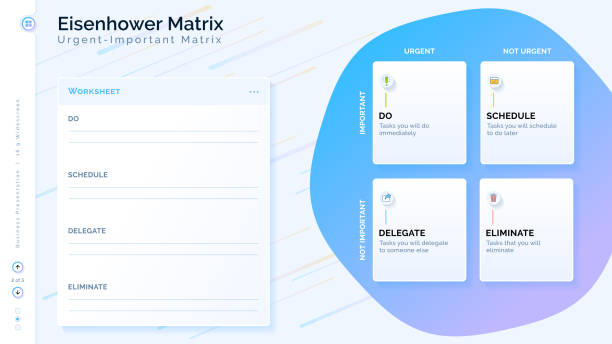The Eisenhower Matrix, often referred to as the Urgent-Important Matrix, is a powerful tool for managing time and priorities. Named after President Dwight D. Eisenhower, who was known for his ability to make tough decisions and manage his time effectively, this matrix provides a framework for categorizing tasks based on their urgency and importance. At its core, the matrix divides tasks into four quadrants: Urgent and Important, Important but Not Urgent, Urgent but Not Important and Neither Urgent nor Important. The crux of its effectiveness lies in its ability to unlock the secrets of dual management—balancing the pressing demands of urgency with the crucial aspects of importance. The Urgent and Important quadrant demands immediate attention. These are tasks that cannot be postponed without severe consequences. It includes crises, deadlines and pressing problems. The key to managing this quadrant is swift and decisive action. President Eisenhower, with his military background, understood the critical importance of addressing urgent matters promptly.
The Important but Not Urgent quadrant is where strategic thinking and planning come into play. These tasks contribute to long-term goals and personal development but often get neglected in the hustle of daily urgencies. This quadrant underscores the need for proactive and preventive measures. Effective leaders and individuals allocate time to these tasks, ensuring they do not escalate into urgent crises. Conversely, the Urgent but Not Important quadrant can be a major distraction. These tasks may seem pressing, but they do not align with overarching goals. Delegating or finding efficient ways to minimize time spent on these tasks is key. A leader who can distinguish between what’s truly important and what merely appears urgent can allocate resources more effectively.

The Neither Urgent nor Important quadrant is the realm of time-wasting activities. Identifying and minimizing these tasks is crucial for optimal productivity and you could check here https://rizen.app/manage-and-plan-important-and-urgent-tasks-with-eisenhower-matrix/. Leaders recognize the importance of protecting their time from activities that do not contribute to personal or organizational goals. In essence, the Eisenhower Matrix provides a lens through which one can evaluate and prioritize tasks, fostering a balanced and efficient approach to time management. It is a roadmap for navigating the dual challenges of urgency and importance, ensuring that time and energy are directed toward tasks that truly matter. By consistently applying this matrix, individuals and leaders can unlock the secrets of dual management, achieving a harmonious balance between the demands of the present and the pursuits of the future.

Eisenhower Matrix Unlocks Important-Urgent Dual Management Secrets!
September 28, 2023
Application
Comments Off on Eisenhower Matrix Unlocks Important-Urgent Dual Management Secrets!
Sean Hernandez
The Eisenhower Matrix, often referred to as the Urgent-Important Matrix, is a powerful tool for managing time and priorities. Named after President Dwight D. Eisenhower, who was known for his ability to make tough decisions and manage his time effectively, this matrix provides a framework for categorizing tasks based on their urgency and importance. At its core, the matrix divides tasks into four quadrants: Urgent and Important, Important but Not Urgent, Urgent but Not Important and Neither Urgent nor Important. The crux of its effectiveness lies in its ability to unlock the secrets of dual management—balancing the pressing demands of urgency with the crucial aspects of importance. The Urgent and Important quadrant demands immediate attention. These are tasks that cannot be postponed without severe consequences. It includes crises, deadlines and pressing problems. The key to managing this quadrant is swift and decisive action. President Eisenhower, with his military background, understood the critical importance of addressing urgent matters promptly.
The Important but Not Urgent quadrant is where strategic thinking and planning come into play. These tasks contribute to long-term goals and personal development but often get neglected in the hustle of daily urgencies. This quadrant underscores the need for proactive and preventive measures. Effective leaders and individuals allocate time to these tasks, ensuring they do not escalate into urgent crises. Conversely, the Urgent but Not Important quadrant can be a major distraction. These tasks may seem pressing, but they do not align with overarching goals. Delegating or finding efficient ways to minimize time spent on these tasks is key. A leader who can distinguish between what’s truly important and what merely appears urgent can allocate resources more effectively.
The Neither Urgent nor Important quadrant is the realm of time-wasting activities. Identifying and minimizing these tasks is crucial for optimal productivity and you could check here https://rizen.app/manage-and-plan-important-and-urgent-tasks-with-eisenhower-matrix/. Leaders recognize the importance of protecting their time from activities that do not contribute to personal or organizational goals. In essence, the Eisenhower Matrix provides a lens through which one can evaluate and prioritize tasks, fostering a balanced and efficient approach to time management. It is a roadmap for navigating the dual challenges of urgency and importance, ensuring that time and energy are directed toward tasks that truly matter. By consistently applying this matrix, individuals and leaders can unlock the secrets of dual management, achieving a harmonious balance between the demands of the present and the pursuits of the future.